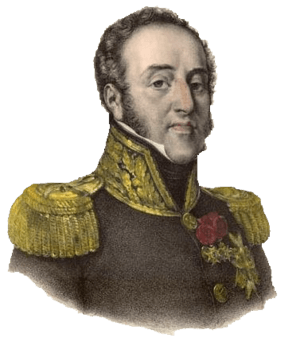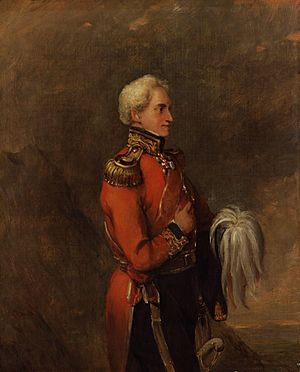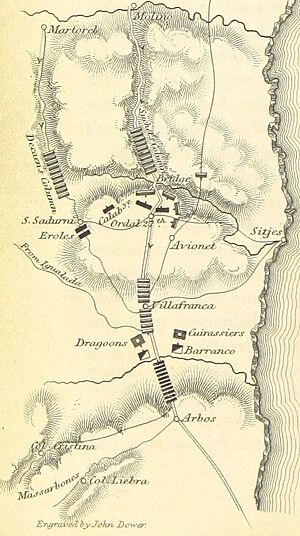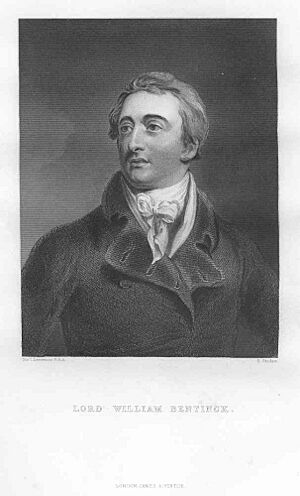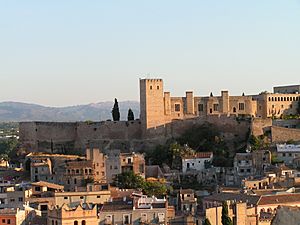Battle of Ordal facts for kids
Quick facts for kids Battle of Ordal |
|||||||
|---|---|---|---|---|---|---|---|
| Part of the Peninsular War | |||||||
|
|||||||
| Belligerents | |||||||
| Commanders and leaders | |||||||
| Strength | |||||||
| Ordal: 17,000 Vilafranca: 1,750 |
Ordal: 20,000 Vilafranca: 770 |
||||||
| Casualties and losses | |||||||
| Ordal: 300 Vilafranca: 107 |
Ordal: 2,000 Vilafranca: 13 |
||||||
The Battle of Ordal was a fight during the Peninsular War on September 12 and 13, 1813. This war was part of the bigger Napoleonic Wars. French soldiers, led by Marshal Louis Gabriel Suchet, attacked a smaller group of British and Spanish soldiers. These Allied troops were led by Lord William Bentinck and Frederick Adam.
The battle happened near Ordal and El Lledoner in Catalonia, Spain. The Allies were in a strong defensive spot, but they were defeated because they didn't have enough guards watching. The next morning, there was a smaller fight between cavalry (soldiers on horseback) near Vilafranca del Penedès. The French won both parts of the battle.
This French victory didn't change the overall situation for France in Catalonia. After this battle, Marshal Suchet's troops were slowly moved away to defend France itself. This forced him to retreat towards the Pyrenees mountains.
What Led to the Battle?
The Peninsular War was a long conflict where France, led by Emperor Napoleon, fought against Spain, Portugal, and the United Kingdom. In 1813, the war was going badly for France in Spain.
Wellington, a famous British general, won a big victory at the Battle of Vitoria in June 1813. This made it very hard for the French to stay in areas like Valencia and Aragon. Because of this, Marshal Suchet had to pull his soldiers back.
Suchet gathered his troops near Barcelona. As the French retreated, the Allied army, led by Lord Bentinck, followed them. Bentinck had about 28,000 soldiers from Spain, Britain, Germany, and Italy.
Suchet decided to attack Bentinck's advance guard, which was a smaller group of soldiers at Ordal. This group was led by Colonel Adam. Suchet planned to attack with 12,000 soldiers. Another French force of 7,000 men would also advance from a different direction.
Before this battle, Lord Bentinck had replaced another general, John Murray. Murray had been too careful and had even abandoned valuable cannons during a siege. So, Bentinck was now in charge of the Allied forces.
Bentinck's army moved forward carefully, reaching Vilafranca by September 5. He joined forces with a Spanish general, Francisco Copons y Navia. This meant Bentinck now commanded about 28,000 troops. These troops were spread out between Tarragona, Vilafranca, and Ordal.
The Battle of Ordal
On September 12, Lord Bentinck went with Colonel Frederick Adam's advance guard to the Ordal Cross heights. This group had about 1,500 men. The Ordal position was known to be very strong for defense. It blocked an important road.
Spanish soldiers had built some defenses there before, but most were destroyed. Colonel Torres arrived with 2,300 Spanish troops to help. A cavalry patrol was sent out but found no French soldiers. Bentinck felt the position was safe and went back to Vilafranca.
Adam's group included soldiers from different countries:
- The 2nd battalion of the 27th Foot (British)
- Rifle companies from a Swiss regiment and a German regiment
- A battalion from the it:Calabrian Free Corps (Italian)
- Four cannons
Colonel Torres commanded three Spanish infantry regiments. Adam placed the Calabrian Free Corps on his left side. The four cannons were placed across the main road, supported by riflemen and British soldiers. Torres's men were to the right of the cannons. The rest of the British soldiers were on the far right. About 150 cavalrymen from the Brunswick Hussars waited behind them.
As night fell, Adam told his men to sleep in their fighting positions. But he made a big mistake: he didn't send out patrols or guard the Lledoner bridge. This bridge was only about a kilometer in front of their position.
That evening, Marshal Suchet left Molins de Rei with 12,000 French troops. They marched quickly and arrived at Ordal at 11:00 PM. Suchet was surprised to find no guards at the bridge. His troops crossed the unguarded bridge and moved uphill towards the sleeping Allied soldiers.
Some Spanish cavalry heard noises and rode forward. They were met with gunfire, which woke up Adam's men. The French 7th Line Regiment, led by General Jean Mesclop, attacked first. They ran into Spanish soldiers in a trench. The Spanish fell back to another defense higher up. They fought back and briefly pushed the French away.
But more French soldiers joined the attack. The 7th Line and 44th Line regiments attacked again and took over the Spanish defenses. Suchet sent more troops, spreading the attack to the left side of the Allied line. This put pressure on the Allied right flank.
Captain Thomas Robert Bugeaud led his troops across a narrow path to the south of the bridge. This group arrived in front of the main British force. Early in the fight, Colonel Adam was wounded. Command was passed to Colonel Reeves, who was also wounded later.
The Spanish soldiers fought bravely. However, the strong French attack finally broke through the Anglo-Spanish right side. As the Allied soldiers ran, Suchet sent his cavalry, the 4th Hussars, to chase them. The Brunswick Hussars tried to stop the chase but couldn't. The 4th Hussars captured all four British cannons and nearly 500 prisoners.
The Calabrian soldiers, who had lost very few men, retreated to the northwest. During the night, they met another French column led by General Charles Mathieu Isidore Decaen. They had to quickly turn around and go south. They eventually reached the coast and were taken away by Allied ships. They lost 51 men.
Colonel Torres's Spanish troops and about 150 British soldiers escaped towards Sant Sadurni. From there, they reached Vilafranca safely.
After the Battle
The Allies suffered heavy losses at Ordal.
- Spanish soldiers: 87 killed, 239 wounded, and 132 missing.
- Adam's brigade: 75 killed, 109 wounded, and 333 missing.
In total, the Allies lost 975 men at Ordal. The French lost about 300 men.
After hearing about the defeat at Ordal and learning that General Decaen's French column was also approaching, Lord Bentinck decided to leave Vilafranca. He personally organized his cavalry to protect the retreat. His 770 cavalrymen included British, Brunswick, Sicilian, and Foreign Hussar regiments.
During this retreat, the Allies lost 25 killed, 69 wounded, and 40 missing. The French lost about 107 men. After this, Suchet stopped his pursuit.
Lord Bentinck admitted his defeat to Wellington. He praised his soldiers' bravery. Soon after, he gave command to Lieutenant General William Henry Clinton and returned to Sicily. Later, Colonel Torres and Colonel Bray were honored for their bravery in the battle.
Even though the French won at Ordal, their overall position in Catalonia was weakening. By late 1813, Suchet had about 46,000 men in Catalonia. However, Napoleon ordered many of these troops to leave Spain and defend eastern France. This left Suchet with only about 17,000 soldiers.
Suchet had to retreat further towards the Pyrenees mountains. He left behind several French garrisons (groups of soldiers guarding fortresses). These garrisons were captured one by one. By the end of the war, only Barcelona remained in French hands. The last French forces in Spain finally surrendered in April 1814, after Napoleon had given up his throne.
See also
 In Spanish: Batalla de Ordal para niños
In Spanish: Batalla de Ordal para niños
- Cross of Ordal from Google Earth


